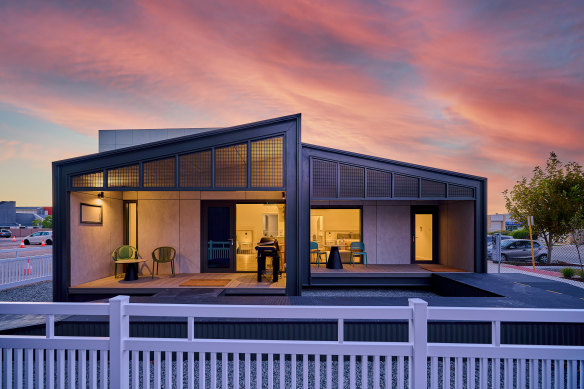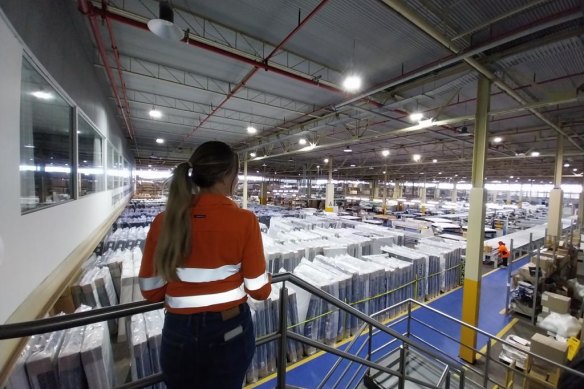In the red dust of a sprawling mining camp about 200 kilometres inland on Australia’s west coast, in one the hottest parts of the country, an oversized donga is about to be delivered on a flatbed truck.
Dongas, the mining industry’s preferred type of portable accommodation, are ubiquitous across remote outback mine sites. Lined up, row-upon-row, side-by-side, they usually provide spartan, utilitarian sleeping quarters; a single bed, shower, toilet, cupboard and not much else.

Donga with a difference. This one boasts a queen-size bed, kitchenette, big TV, lounge, balcony with a barbecue, laundry and en suite.Credit:
The one destined for Mineral Resources’ future iron ore mine at Ken’s Bore, just south of Karratha near the top of West Australia, is different. Three times normal size, it boasts a queen bed, kitchenette, big TV, lounge, balcony with a barbecue, laundry and en suite.
The donga’s transformation – mining companies now prefer to call them pods – is both a symptom of the mining industry’s success and West Australia’s booming economy and consequent low unemployment. Jobs in Western Australia jumped 1 per cent in July giving the state an unemployment rate of 3.4 per cent, below the national average, and leaving employers scrambling.
In a bid to attract workers, once inhospitable, harsh outback mining camps are taking a cue from resorts.
At select mines, fly-in fly-out workers can now enjoy Olympic-sized swimming pools, feast for free in gourmet mess halls, exercise in full-feature gyms, take cooking classes and yoga sessions, or drive golf balls on indoor simulators in their free hours.
Mining companies are spending big to make female-friendly workplaces and create safe, diverse communities that welcome couples.
“Our big focus is getting a lot more women into our workforce,” says Mineral Resources’ billionaire executive Chris Ellison.
“We need to change the way we’re building these camps. It doesn’t work anymore because we’re getting mental health issues. We’ve got a lot of blokes that get into the wet mess and they become inappropriate with their behaviour. So, we’re trying to turn them into communities.”
‘We need to change the way we’re building these camps. It doesn’t work anymore because we’re getting mental health issues.’
Mineral Resources’ boss Chris Ellison
“To do that we’ve got to have an environment where they [women] are safe. They’re high quality, the women that we’ve got now. They’re better dump truck drivers, they’re better at a whole lot of different things.”
Catering for a diverse workforce with differing tastes and needs costs money.
Ellison says his company typically spends about $55 million to construct an old-school 250-person mining camp. With extra frills, it now costs nearly three times that, around $140 million. But they’re worth every cent, he says.
Construction is under way on the first of two new “resorts” to house workers at the company’s $2.1 billion Onslow iron ore project in the Pilbara, slated to have annual capacity of 35 million tonnes. The dongas are destined for the 500-room Ken’s Bore mine site, and another 250 will form part of the Onslow camp near the port on Western Australia’s coast, where the company is also building permanent housing and childcare for its future workforce.
“Why do we do that? Because we need to add 3000 to 4000 more people over the next 18 months to two years. We need good quality people. How do I pay for all that? I’ll have a high-quality workforce. We’ve got them lining up wanting to come and work for us because the conditions that we’re putting in are unheard of in the mining industry,” Ellison says. “It’s literally like going into the Cable Beach Resort,” he says.

BHP has just placed an order for 11,000 hotel-standard king single beds with a family-run Sydney business.Credit:
Kate Holling, general manager of infrastructure for global mining giant BHP’s West Australian iron ore operations, says about 36 per cent of her team are female. BHP is striving for a diverse 40/40 gender split with 20 per cent floating, depending on the skill set required.
Holling has responsibility for the 11,000 rooms the company owns across the Pilbara in which, on any given day, it is accommodating and feeding up to 12,000 people. It’s an enormous fly-in, fly-out effort overseeing about 700,000 passenger movements a year, the equivalent of all commercial airline flights on the Perth to Bali route. “It’s a pretty industrial operation. We serve around 6 million meals a year, and about 2.5 million hot dinners,” she says. “We’re spending 30 per cent more this year on food than we did two years ago.”
Like Mineral Resources, BHP’s newer camps feature couples rooms, Olympic-sized swimming pools, virtual golf simulators, state-of-the-art squash courts and sports facilities. However, it has an added problem – upgrading its ageing dongas.
Many of the company’s 11,000 rooms are more than 25 years old. “Really creative thinking” has gone into renovating them and keeping them competitive with what workers want, Holling said.
The company has just placed an order for 11,000 hotel-standard king single beds with a family-run Sydney business.
“Having happy people with a good night’s sleep and a positive mindset is super important when they front up to the mine from a safety perspective, mental health perspective, and turnover perspective,” she says.
Loading
And, she is starting to renovate villages with hotel-standard cabin interiors that can withstand the Pilbara’s ubiquitous red dust, mould and heat, and which feature Wi-Fi, entertainment options, dimmable LED lighting and bedside USB charging. “Stuff that really matters to residents staying in the rooms,” Holling says.
Curtain University professor Sharon Parker sees “definite positives” in the mining industry’s efforts to upgrade physical standards and make remote workplaces safe and secure for women.
“It probably is a signal to the workers that management are making an effort and trying to improve the quality of their time away from home,” Parker says.
But a recent survey of more than 3000 FIFO workers and their partners by the university shows the industry is still grappling with a highly masculine work culture, bullying, harassment and – particularly for women – sexist hostility.
“More than one-third of women are regularly experiencing sexist hostility,” she says, often in the form of dirty jokes or inappropriate comments.
Loading
An important driver for mental health and well-being among FIFO workers is their roster structure, she says. Two weeks on, two weeks off is far better for workers’ mental health than three on, one off.
“This is partly because the longer you’re away, the more disruption there is to your family. But also from a fatigue perspective. Many of the people working on mine sites are working very long hours, they’re very tired. It takes time for people to recover,” she says.
Workers with job security and permanent accommodation on site fare better mentally, she said. And social activities make a huge difference because loneliness is often a big factor.
Mineral Resources’ executive general manager for people, Andrea Chapman, said its Onslow mine will run on a family-friendly eight days on, six days off, seven nights on, seven nights off roster. All the company’s existing camps have health and wellbeing co-ordinators, sports activities and social engagement plans.
“When you make these locations more attractive, you start opening your talent pool … and therefore it’s likely to attract more women,” Chapman said.
Stay connected with us on social media platform for instant update click here to join our Twitter, & Facebook
We are now on Telegram. Click here to join our channel (@TechiUpdate) and stay updated with the latest Technology headlines.
For all the latest Business News Click Here
For the latest news and updates, follow us on Google News.
